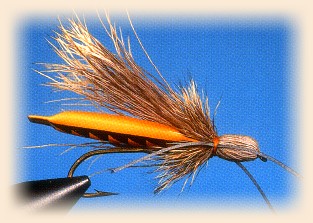O2 Stonefly Adult
Created by Robert Williamson, Roy, Utah
By Al and Gretchen Beatty
Robert tells us about this great new pattern, "I work
in the electrical/lighting industry. One day I was
talking to a sales representative who was filling our
shelves with heat shrink tubing. As the rep was putting
the different diameters of tubing on the shelf, I
noticed that the orange-colored tube was about the
same diameter as an adult stonefly body (funny how
that thought popped into my head while I was at work).
The tubing was made of polyolefin and had a glue coating
inside allowing it to be sealed. I also learned a design
could be printed on it with a special machine. I drew up
a simple design, took it to the factory, and they printed
me samples for experimentation." With this great,
newly-adapted material Robert was able to develop this
innovative pattern. It's another example of the many
flies we've seen tied from materials developed for
industries other than fly-fishing.
Publisher's Note: The body material is only
available directly from Robert. You can reach him at
either:
rwilliamson@century-lighting.net or
flywarfish@aol.com
We feature this fly in hopes of inspiring tiers to think
outside the box when creating flies for their specific
use or region.
The pattern should be used to imitate Pteronarcys
californica (salmonflies) which hatch on many
western rivers from late May through early July. Robert
fishes it using standard dry-fly techniques. Its air-filled
design makes it virtually unsinkable and it is certainly
easy to tie.
Materials for O2 Stonefly Adults:
Hook: Size 6, 3XL dry fly.
Thread: Orange.
Body: Pre-marked O2 Body Material.
Wing: Light elk hair.
Head: Natural deer or black closed-cell foam.
Legs: Black rubber leg material.
Instructions - O2 Stonefly Adults:
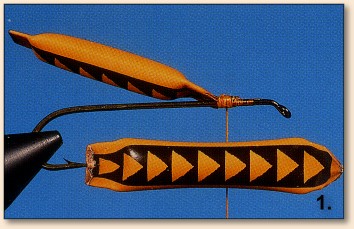
Step 1: Cut a section of O2 Body Material that is equal
in length to the hook shank and taper one end with a
pair of scissors. Heat a set of wing burners then use
them to seal that end of the material. Seal the other
end of the body using the same process. Place a hook
in the vise and apply a short thread base about 1/4 of
the way back on the shank from the eye. Tie the body
to the hook by the tapered end. Here we've illustrated
a body temporarily stuck to the hook point and another
identical body already mounted on the shank. Note the
un-tapered end of the body is stuck to the hook point.
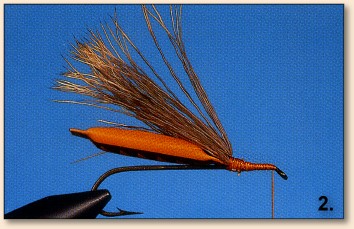
Step 2: Select, clean, and stack a clump of elk hair.
Tie it to the hook as a Trude-style wing slightly
longer than the body. Trim off the waste ends and
advance the thread to the hook eye.
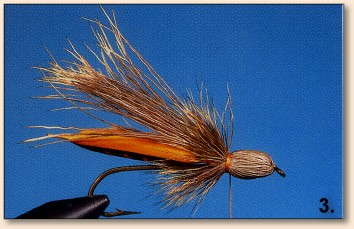
Step 3: Cut a clump of elk hair from the hide, remove
the under fur, and even the tips in a stacker. Tie
them to the hook with the tips pointing forward from
the eye. Trim off the waste ends then cover wrap them
with the tying thread. Leaving the thread back at the
1/4 position on the shank. Sweep the fibers back, form
a bullet head, and bind them in place with several
thread turns.
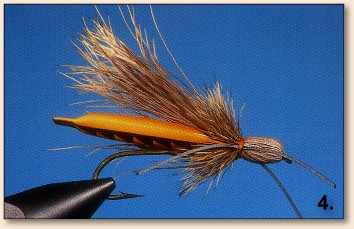
Step 4: Select two sections of black rubber leg material
each about 1 1/2 inches long. Tie one of them on the off
side of the hook in the center of the piece and then repeat
the process with the other on the near side of the shank.
Whip finish and remove the thread. Apply a coating of
Aqua Head to the thread wraps to finish the fly. ~ Al and Gretchen
About Robert Williamson
Robert's first memories of fly-fishing come from family
trips to a beautiful, small creek in southeast Idaho. His
father was a fly-fisher and many weekend camping trips
were spent on this beautiful stream. Robert remembers
following his dad up and down the creek with his older
brother Jerry. It was a magical time. His dad's fly
line would travel through the air and it seemed that
every time it landed on the water a nice cutthroat
trout would attack it. Robert was fascinated with
the sights and sounds of the creek, and especially
with the colorful trout.
As he got older Robert decided he wanted to catch
trout like his dad and would spend time with his
own equipment tying to catch a fish. Robert remembers
becoming very frustrated at first because all he
seemed to catch was the branches of willows and
pines. By the age of thirteen he gained the casting
skills he needed to be a successful angler. Most of
his fishing consisted of casting Potts hair flies
down and across stream, catching eager cutthroats
from the creek.
Robert, his brother Jerry, and their dad have pursued
trout on this same little creek for over thirty-five
years now. It is a place of memories and a place
where memories are still made.
Early on Robert learned from his dad he only needed
one or two flies. They were the Potts Fizzle and the
Rock Worm. He spent all of his teenage years fishing
these two patterns catching his fair share of trout.
These flies were purchased and the thought of tying
them never crossed Robert's mind until he was into
his twenties and the flies became increasingly
difficult to find. He would just have to learn to
tie them himself and Robert did so by taking apart
the originals to study their construction secrets.
Robert's version caught fish as well as the original,
and certainly added a new excitement and dimension
to his fly-fishing. He became fascinated with the
"old time" western tiers like George Grant. Again
he went to work studying and replicating Grant's
flies. Soon Robert was experimenting on his own
using new materials with old techniques and vice
versa; designing patterns he could call his own.
Robert works as a commercial and residential lighting
consultant to pay the bills. He has also dabbled in
professional fly-tying and writing about the outdoors.
His pieces have appeared in Utah Fishing, Fly Tying,
Fly Fishing, and Fly Fishing & Tying Journal. Robert
wrote a book on his favorite subject entitled
Creative Flies: Innovative Tying Techniques,
published by Frank Amato Publications. He lives in
Roy, Utah with his wife Phyllis and three children,
Kassie, Mikel, and Ryan. The Williamson family enjoys
spending time at their cabin in Bear Lake, Idaho where
they relax, swim, camp, and, most importantly, fish.
Credits: The O2 Stonefly Adult is from Al & Gretchen Beatty's book,
Innovative Flies and Techniques, published by Frank Amato
Publications, (2005). You can read a review of this terrific book
HERE.
|

